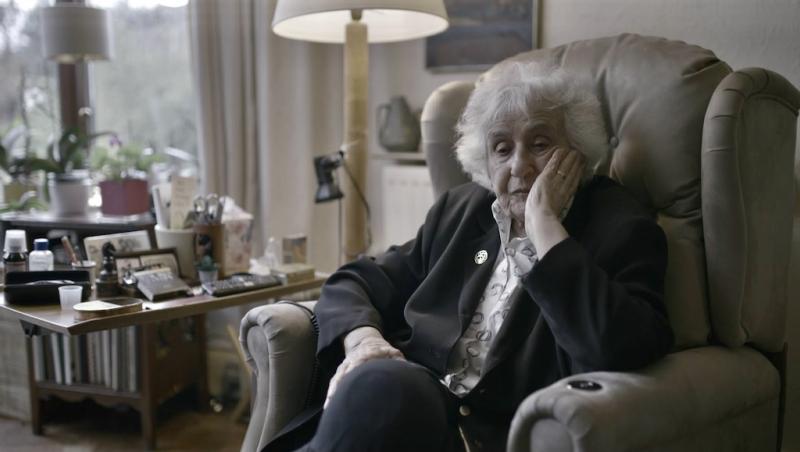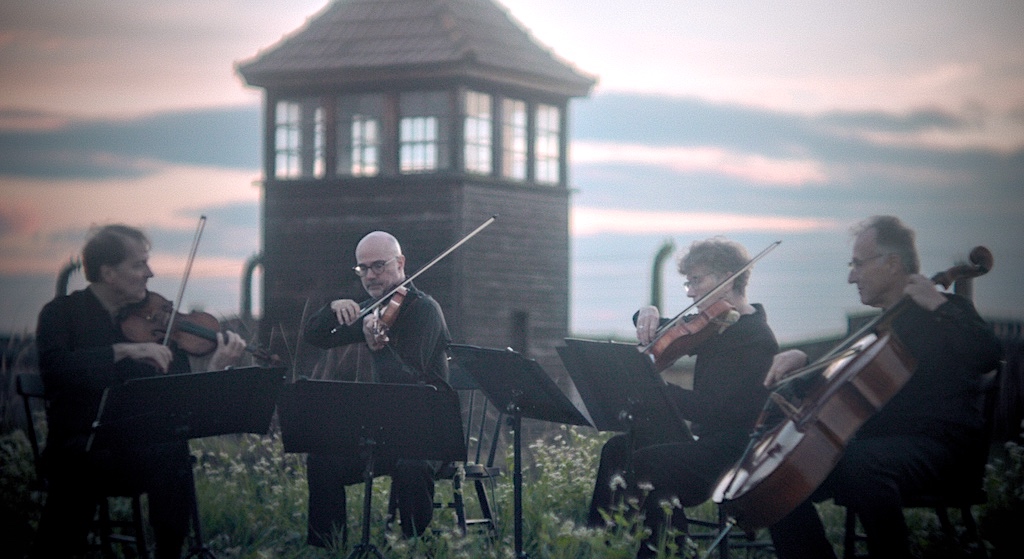The Last Musician of Auschwitz review - a haunting testament | reviews, news & interviews
The Last Musician of Auschwitz review - a haunting testament
The Last Musician of Auschwitz review - a haunting testament
When fine music was played in a death factory

“It is so disgraceful, what happened there,” says Anita Lasker-Wallfisch, in a comment that is the understatement of the century. She is referring to the genocide perpetrated by the Nazis in concentration camps like Auschwitz-Birkenau, where she was held prisoner.
Six million Jews were murdered in the camps, but Lasker-Wallfisch survived because she was a musician. She describes the “welcoming” ceremony in which arrivals were “stripped of every vestige of human dignity”. Stark naked, they had their heads shaved and a number tattooed on their arms.
But the woman conducting this identity-destroying process discovered that Lasker-Wallfisch played the cello, an instrument that was desperately needed in the camp orchestra. An audition was held in which, recalls Lasker-Wallfisch with wry humour, “I wasn’t on top form”. But she was accepted by the conductor and thus avoided dying either through hard labour or the gas chambers.
After the war, she moved to London and became a founder member of the English Chamber Orchestra. At 99, she is the last surviving member of the 15 orchestras that played in Auschwitz, and we see her giving a masterclass to her son Raphael, who is also a fine cellist.
In this first-rate documentary, director Toby Trackman (winner of a Grierson award for Stabbed) focuses on Lasker-Wallfisch (whose words as a young woman are spoken by Katie Shalka) and three other musicians incarcerated by the Nazis because they were Jewish. Using archival stills, footage and interviews, along with actors who, speaking to camera, bring to life the musicians' published memoirs, Trackman creates an incredibly vivid account of life in the camps.
Broadcaster Jonathan Freedland provides razor-sharp insights into the motivation behind the genocide that Hitler called “the final solution” while the music performed by camp orchestras is played in the grounds of Auschwitz by a string quartet that includes Raphael Wallfisch. I challenge anyone to keep a dry eye during these moving recitals.  Songwriter Ilse Weber (whose words are spoken by Rosalyn Mitchell) was sent from Prague to Theresienstadt, the camp where prominent Jewish artists, writers, scientists, musicians and scholars were held. She ran the children’s infirmary and wrote songs to lift the spirits of the little ones.
Songwriter Ilse Weber (whose words are spoken by Rosalyn Mitchell) was sent from Prague to Theresienstadt, the camp where prominent Jewish artists, writers, scientists, musicians and scholars were held. She ran the children’s infirmary and wrote songs to lift the spirits of the little ones.
In October 1944, four months before the camp's liberation, she and the children were sent to the gas chambers at Auschwitz. A kindly guard advised them to sing with gusto, so they would inhale the gas deeply and die quickly, and thereby avoid being trampled in the general panic that would ensue. Liv Migdal (pictured above) sings a song written by Weber in which she yearns for her son, Hanus, who had previously escaped to England on the Kindertransport.
Conductor Adam Kopycinski was sent to Auschwitz in 1942. In his memoir (spoken by Laurence Dobiesz), he described how the musicians were able to create a parallel world inside the high-voltage perimeter fence. New arrivals were lulled into a false sense of security by Mozart’s "Eine Kleine Nacht Musik" played by some of the finest musicians in the world. Every morning at dawn, in temperatures that could be as low as minus five degrees, they played jolly marches for the thousands dragging themselves off to work in factories and quarries. Returning after a day of hard labour, the exhausted workers were again serenaded with marches.
On Sundays, the musicians gave concerts for the SS Officers. Composer Szyman Laks was sent to Auschwitz from Paris. He recalled (in words spoken by Dan Blaskey) Josef Mengele – the doctor whose speciality was torturing young children in the name of science – requesting "Träumerei (Dreaming)" from Schumann’s "Kinderszenen (Scenes from Childhood)" and shedding tears during this nostalgic piece about childhood reverie. “How could people who love music to this extent,” he asks, “be capable of committing so many atrocities on the rest of humanity?”
Dr Mengele experimented on the Roma children imprisoned in the nearby "Gypsy family camp". Overnight on 2 August 1944, 4,300 Roma were gassed. Petra Gelbart, the granddaughter of Romany survivors, sings "Oh You Little Blackbird", a melancholy song about hunger, written in Auschwitz. As an act of resistance against centuries of persecution, Gelbart now teaches her children the Romani language. Playing Jewish music was outlawed, but Szyman Laks risked death by continuing to compose. One day, drawn by the sounds of a new quartet that Laks was perfecting, an SS officer walked in on their rehearsal. “Whose music is that?” he asked. The quick-witted Laks cited an obscure Austrian composer. “Beautiful," the officer replied, "you can tell it’s German music.”
Playing Jewish music was outlawed, but Szyman Laks risked death by continuing to compose. One day, drawn by the sounds of a new quartet that Laks was perfecting, an SS officer walked in on their rehearsal. “Whose music is that?” he asked. The quick-witted Laks cited an obscure Austrian composer. “Beautiful," the officer replied, "you can tell it’s German music.”
Trackman’s superb film is like a masterclass in how to make a documentary. Do we really need another film about Hitler’s extermination camps, though? The answer has to be a resounding “yes”. Given the current rise of right-wing extremism across Europe and in Israel and the US, this reminder of the atrocities committed by fascists whom some people now revere is not just timely, but an absolute necessity.
“What have we learnt ?” asks Lasker-Wallfisch. What, indeed?
rating
Explore topics
Share this article
The future of Arts Journalism
You can stop theartsdesk.com closing!
We urgently need financing to survive. Our fundraising drive has thus far raised £49,000 but we need to reach £100,000 or we will be forced to close. Please contribute here: https://gofund.me/c3f6033d
And if you can forward this information to anyone who might assist, we’d be grateful.

Subscribe to theartsdesk.com
Thank you for continuing to read our work on theartsdesk.com. For unlimited access to every article in its entirety, including our archive of more than 15,000 pieces, we're asking for £5 per month or £40 per year. We feel it's a very good deal, and hope you do too.
To take a subscription now simply click here.
And if you're looking for that extra gift for a friend or family member, why not treat them to a theartsdesk.com gift subscription?
more Film
 Beating Hearts review - kiss kiss, slam slam
Romance and clobberings in a so-so French melodrama
Beating Hearts review - kiss kiss, slam slam
Romance and clobberings in a so-so French melodrama
 Materialists review - a misfiring romcom or an undercooked satire?
Writer-director Celine Song's latest can't decide what kind of film it is
Materialists review - a misfiring romcom or an undercooked satire?
Writer-director Celine Song's latest can't decide what kind of film it is
 theartsdesk Q&A: actor Leonie Benesch on playing an overburdened nurse in the Swiss drama 'Late Shift'
The Guildhall-trained German star talks about the enormous pressures placed on nurses and her admiration for British films and TV
theartsdesk Q&A: actor Leonie Benesch on playing an overburdened nurse in the Swiss drama 'Late Shift'
The Guildhall-trained German star talks about the enormous pressures placed on nurses and her admiration for British films and TV
 Freakier Friday review - body-swapping gone ballistic
Lindsay Lohan and Jamie Lee Curtis's comedy sequel jumbles up more than their daughter-mother duo
Freakier Friday review - body-swapping gone ballistic
Lindsay Lohan and Jamie Lee Curtis's comedy sequel jumbles up more than their daughter-mother duo
 Eight Postcards from Utopia review - ads from the era when 1990s Romania embraced capitalism
Radu Jude's documentary is a mad montage of cheesy TV commercials
Eight Postcards from Utopia review - ads from the era when 1990s Romania embraced capitalism
Radu Jude's documentary is a mad montage of cheesy TV commercials
 The Kingdom review - coming of age as the body count rises
A teen belatedly bonds with her mysterious dad in an unflinching Corsican mob drama
The Kingdom review - coming of age as the body count rises
A teen belatedly bonds with her mysterious dad in an unflinching Corsican mob drama
 Weapons review - suffer the children
'Barbarian' follow-up hiply riffs on ancient fears
Weapons review - suffer the children
'Barbarian' follow-up hiply riffs on ancient fears
 theartsdesk Q&A: filmmaker Dag Johan Haugerud on sex, love, and confusion in the modern world
The writer-director discusses first-love agony and ecstasy in 'Dreams', the opening UK installment of his 'Oslo Stories' trilogy
theartsdesk Q&A: filmmaker Dag Johan Haugerud on sex, love, and confusion in the modern world
The writer-director discusses first-love agony and ecstasy in 'Dreams', the opening UK installment of his 'Oslo Stories' trilogy
 Oslo Stories Trilogy: Dreams review - love lessons
First love's bliss begins a utopian city symphony
Oslo Stories Trilogy: Dreams review - love lessons
First love's bliss begins a utopian city symphony
 Blu-ray: Two Way Stretch / Heavens Above!
'Peak Sellers': two gems from a great comic actor in his prime
Blu-ray: Two Way Stretch / Heavens Above!
'Peak Sellers': two gems from a great comic actor in his prime
 Late Shift review - life and death in an understaffed Swiss hospital
Petra Volpe directs Leonie Benesch in a compelling medical drama
Late Shift review - life and death in an understaffed Swiss hospital
Petra Volpe directs Leonie Benesch in a compelling medical drama
 The Naked Gun review - farce, slapstick and crass stupidity
Pamela Anderson and Liam Neeson put a retro spin on the Police Squad files
The Naked Gun review - farce, slapstick and crass stupidity
Pamela Anderson and Liam Neeson put a retro spin on the Police Squad files

Add comment